A slip board fence is an inexpensive solution to fencing for a large yard. While it looks like it’s an easy DIY project, it’s only as easy as the terrain and your DIY skills allow. Here’s what you need to know about how to build a slip board fence. And find out a few pro fence tips that will get you in the best position for a successful project.
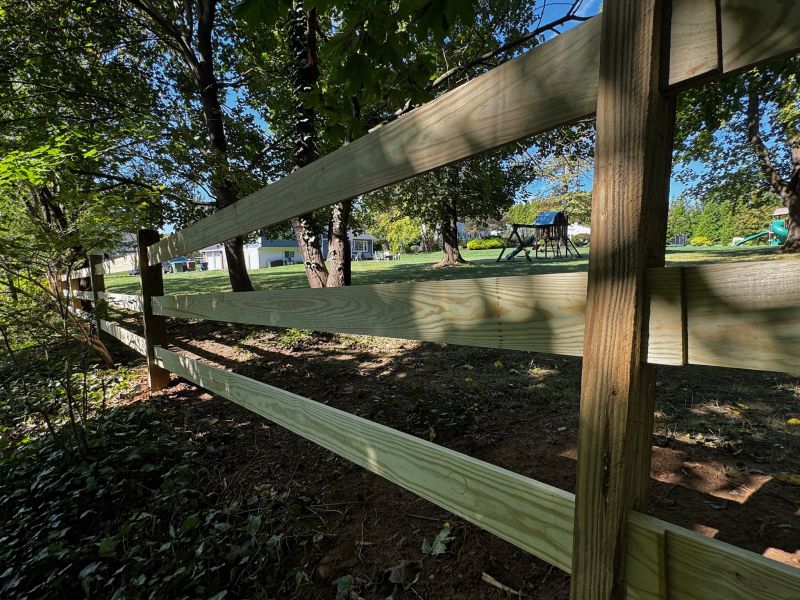
In this blog I will cover:
- What is a slip board fence?
- Why a slipboard fence is awesome?
- Pro and DIY tips that can help you build a slip board fence.
- Is equipment rental worth it?
- What do I do if there an existing fence or tree in the way?
What Is a Slip Board Fence?
Slip board fences are made of horizontal planking–usually a set of three–placed through post pockets. Very similar to split rail fencing, but also markedly different. The main reason is that they don’t set into the post, they slip through them. And a slip board fence is an elegant solution to problems split-rail and fence and panel fences can’t easily solve.
So, unlike 6×8-foot fence panels or even split rail fences, you can adjust the slip board post spacing by feet. As long as adjoining posts look the same as each other, they all look the same.
While they look great, modern, clean, linear, slip board seems to come from the agricultural community. There’s not a lot of suburban detail requirement here, but I love the mojo. If you need to get a machine in–-or a horse out–-it just takes a few moves. In a horse situation where they bray against the pen, the slip boards flex.
For me, I’ve used 1x6x8 pressure treated on a fence I visit that’s years old. Here, we use 11-foot spacing for 12-foot-by-1-by-foot boards.
Ordering Slips from a Supplier
Slip board posts and split rail posts are similar, in most cases almost identical. However, they’re NOT the same. Slip board posts have about a 1-inch deeper pocket than split rail fence posts.
“BigFence” will sell DIY/Pro material for slips (Theresa calls them “slips” and every time she says it I sing Puttin’ on the Slips for a fortnight) or split. But some pro lumber yards don’t know what slip board is. They might be able to get it, but you have to ask.
Slip boards are 1x6x12 or 5/4x6x12 (deck boards) and the posts correspondingly accept them. Split rail posts DO NOT accept 6-by material and the posts must be modified (the holes made bigger) and each post modification takes about 10 minutes. All of those 10 minutes add up to a lot of time.
Tools and Equipment
MyFixitUpLife is set up equipment-wise for fences. All the tools and equipment we use for our world famous wood decks or pole buildings are in-line with fences: Tractor and auger, mighty Ford F-450 dump truck, basic carpentry tools.
We can also hang crown molding or super insulate your basement remodel.
But depending on the terrain, fence building can be hard, unforgiving work.
Layout
Dead plumb and right up against the stringline is nonnegotiable with any fence. What is negotiable with slip board is movement in what I call the left/right axis. If there are rocks, ledge, trees, stumps, the 6×8 matrix of a fence panel is non-negotiable.
There’s a little more give with split rails because you can recut the split rail fence taper with a chainsaw, but it’s a lot of work. With a slip board fence, you can tweak layout by about 2 feet. As long as the adjoining sections are the same as each other, they look the same.
Layout Tip – Gas Pipe
Sure, there are various ways to use stakes to hold a string line taught, but they’re catch-as-catch-can with hard ground, keeping them straight and not having them split when you 2-pound sledge them into the ground.
Instead, I use two 2-foot sections of gas pipe. To make piercing the ground easier, I sharpen a point on it using my angle grinder and an abrasive wheel. It goes in straight, doesn’t break and doesn’t move. And by giving it a good whack when I’m done that run, it pulls out pretty easily.
Earthwork
One of the things that sets us up for fencing is my Power-Trac front-end loader. The machine is brilliant–-furlongs past the skid steer models in my opinion. I bought mine for one reason: Augering deck footings. It has become its own enterprise in the MyFixitUpLife empire–and is central to how and why we can compete in the fence business.
I use it with the forks to set out material, to mix and transport concrete with the bucket and to rescue distressed properties with the mower attachment. And it put me in the snow removal business. I bought a used unit. It has paid for itself many times over.
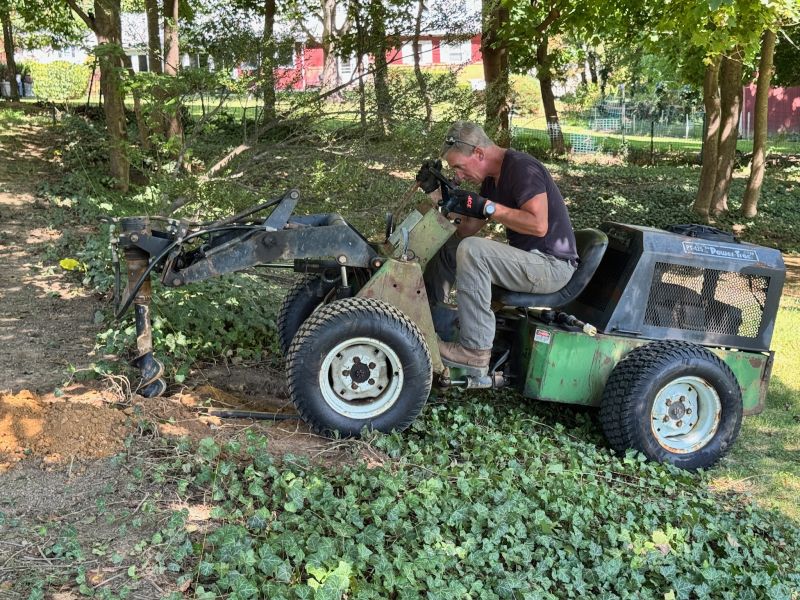
Soil
I’ve dug lots of holes in my county. Sure, there are complications like tree roots and stuff buried like bricks previous homeowners couldn’t figure out how to dispose of. But I hit a clay during this fence project that the slightly worn teeth on my 10-inch auger couldn’t cut or rupture. I tried pilot holes with my 8-inch auger to no avail.
Solution for us: Our Craftsman D-handle chipping hammer set to chip-only. I could break out “lifts” of clay with a 1½-inch spade iron. Get back on the auger to pull it out. Rinse. Repeat.
Lesson learned: Always have a back-up set of auger teeth. In this case, “slightly dull” contributed to a super slow down. That said, I’ve never seen dirt this hard. New teeth may not have made a difference.
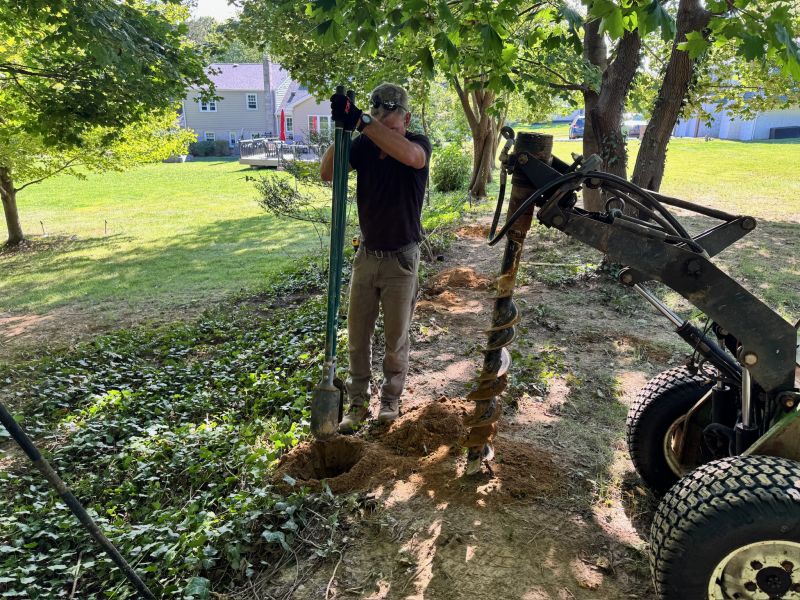
Rent vs. DIY
I recall some long distant vision that anything hydraulic would just magically empty holes I needed emptied. I suppose there is some version of that if your equipment is in the 10,000-pound category and dirt made from Captain America’s shield won’t stop your auger.
I’ve also rented a track loader/skidsteer from The Home Depot for my world famous horse barn video. The Big Box people understand the Big Box sales system. They’re not great at knowing what we run into in the field. Maintenance-wise, they can’t they really support them. And after the machine leaves the store, they want you to interact online if you have a problem.
For a fence project, I wouldn’t rent a machine/auger with anything other than new auger teeth.
Can holes be dug with post hole diggers, shovels and a digging bar? Absolutely. Can it be DIY over a couple/three weekends? Yes. But, post-hole diggers don’t dig anything. They scoop loose soil. Loose soil is generated by an auger like my tractor, shovel, or a digging bar.
It’s physically demanding, and it’s rough. But you can dig those holes the same way you might eat an elephant: One bite at a time. Better: Work in sections. Do 2-3-4-5 sections, take them to completion and then back after it another time.
Posts
Slip board posts are milled differently than split rail posts. So, if you’re building a slip board fence you need to (A) modify a split rail post or (B) get posts milled for 6-by square stock. On this fence, our supplier, the great and powerful Niece Lumber only sells split rail fencing and posts, so I had to modify.
One of the things that I adore about slip board fences is that I can alter post spacing along that string line. Especially in a suburban setting with big yards, I can tweak where a post goes easily by 12-inches–-and a few feet, if I play a trick–-to hopscotch a boulder, giant tree, whatever.
Do I Need to Set Fence Posts in Concrete?
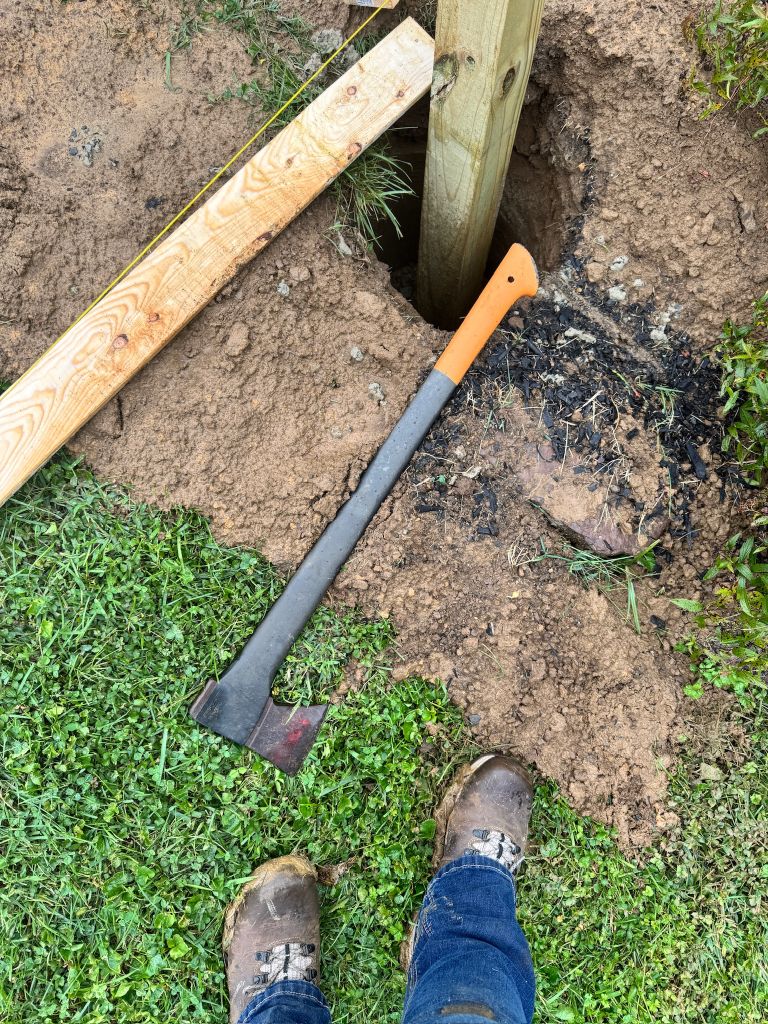
For a carpenter who doesn’t just build fences, I’ve built all kinds of fences. I’ve built them in all kinds of soil.
As it relates to slip board fencing, as a general rule, I’d say mixed concrete at gates and corners only. To quote a BigFence company I spoke with: There’s no wind-load on a slip board fence. And the soil conditions where I build border on barely diggable to not diggable.
For panels, I do at least use combined bags of readi-mix and fast-set.
My client liked that I dropped some concrete in the hole, so that’s what I did.
How to Set Posts and Post Height
Post height and fence straightness is based on post depth, not what the grade is doing 300-feet from your kitchen window.
Small yard, in-town fences require some nuance managing post height because the client is right on top of the fence. Suburbs require less scrutiny. Unless they don’t.
Assuming reasonably flat (not level) grade, do you even out the post tops between end posts or do you follow the grade undulation?
There’s no right answer, really. Where we build (Montgomery County, PA, in the Philadelphia suburbs) post depth for a fence is 30 inches. For deck footings and structural footings, it’s 36 inches.
If you follow grade, you follow grade and the fence panels will rise and fall accordingly. The lumps in the grade will show up at the post-tops. If you try to get the post-tops even–-and this is a good bit more work–-you may end up cutting posts and/or digging shallower holes. The unevenness will show up under the bottom slip board. It doesn’t take much for them to be in the dirt. And then you have frost heaves to worry about.
Posts and “Centering”
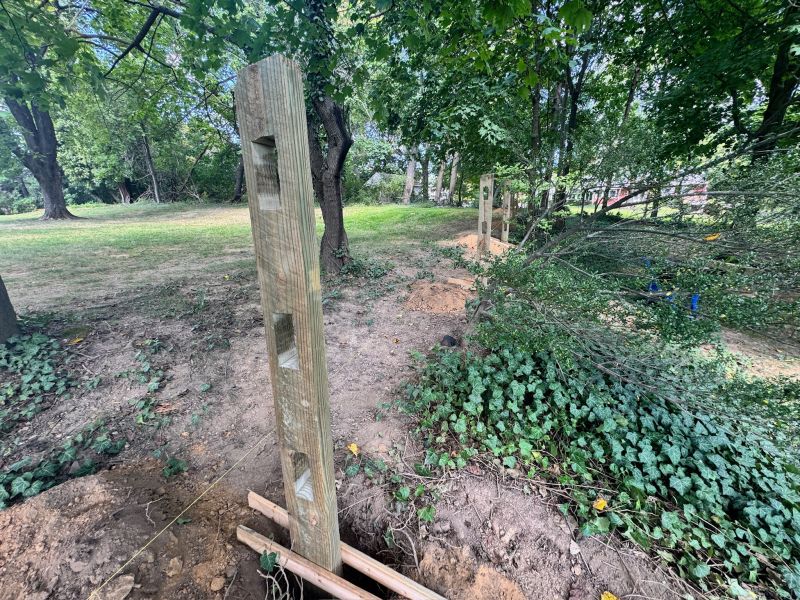
Slip boards are forgiving unlike panels and even split rail fences. For 12-foot boards, I layout the posts at 10-feet 6-inches. Does BigFence who does this every day have a slightly more efficient balance? 3,000 percent chance.
However, when I say “suburbs”, these are 80-year-old suburbs. There are trees, stumps, and adjoining untouched landscaping. There are chainlink fences and bamboo.
When things get in my way, It requires “centering.” In other words, if there’s an interruption in sequence between Panel A and Panel B such that Panel C shows up short, the secret is to center the post between panels A and C.
Gates and Post Spacing
Of the many fences I’ve built, I basically set the corner and layout from there. However, some fences have random interruptions like this one, for a gate. A layout change is another example.
All that is to say: Layout doesn’t have to be from the corners of the property in. If you have a gate that interrupts layout, maybe set the gate opening first and work from there to the corners, adjusting post spacing as needed. .
Posts and Giant Trees
Got an 8-inch-thick tree root in your way? Don’t dig it, cut it.
I notched a monster pine tree root on this fence, cut the slipboard post to height then bolted the post to it with a couple of 5/16 x 6-inch Spax PowerLags.
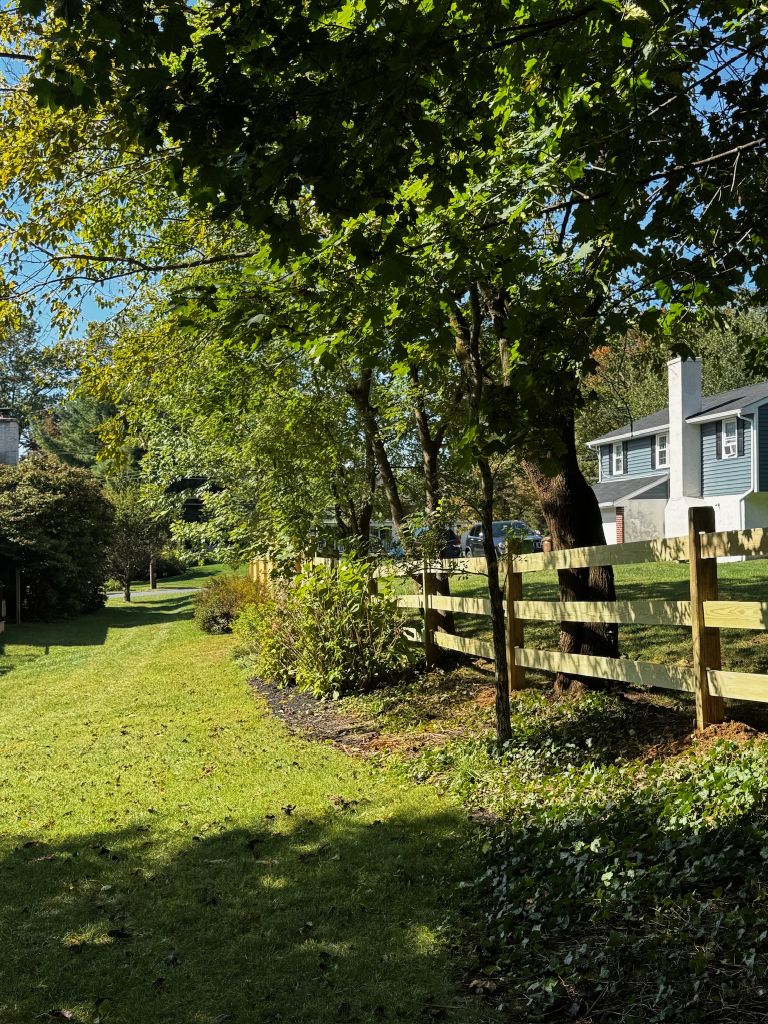
FAQs About Building a Fence
Can I build a fence by myself?
Yes.
How hard is it to build a fence?
Hard. More physical than mental. But there’s plenty of mental.
Do slip board fence posts require concrete?
No. There is no wind load on a slipboard fence. However, Tamping the soil in 12-inch “lifts” will help filling the hole back in and securing the posts
Can I pour dry concrete mix in the hole and let ground water activate it?
You can. I wouldn’t. Stuff happens to the fence long before the ground water-concrete mix ever happens.
How deep should my slip board fence posts be?
Where we build, post-depth is 30 inches. I’m sure it varies in other places for other reasons.
Do I need to fasten my slip boards or can I just leave them as is?
No. I’ve seen lots of slip board fences with 5/4 x 6 deck board rails that don’t appear to be fastened. In this fence we used “appearance grade” 1×6. I see no measurable difference in residential use. I’ve also repaired a fence and spanned 1×6 8-feet with them screwed to the posts. They’re dead straight years later. With that in mind, we blasted 2½-inch screws from the back to hedge our bets against boards that may twist as they dry out.
Is it hard to remove a split rail fence?
If you have to remove a split rail fence, it might be easier than you think.

